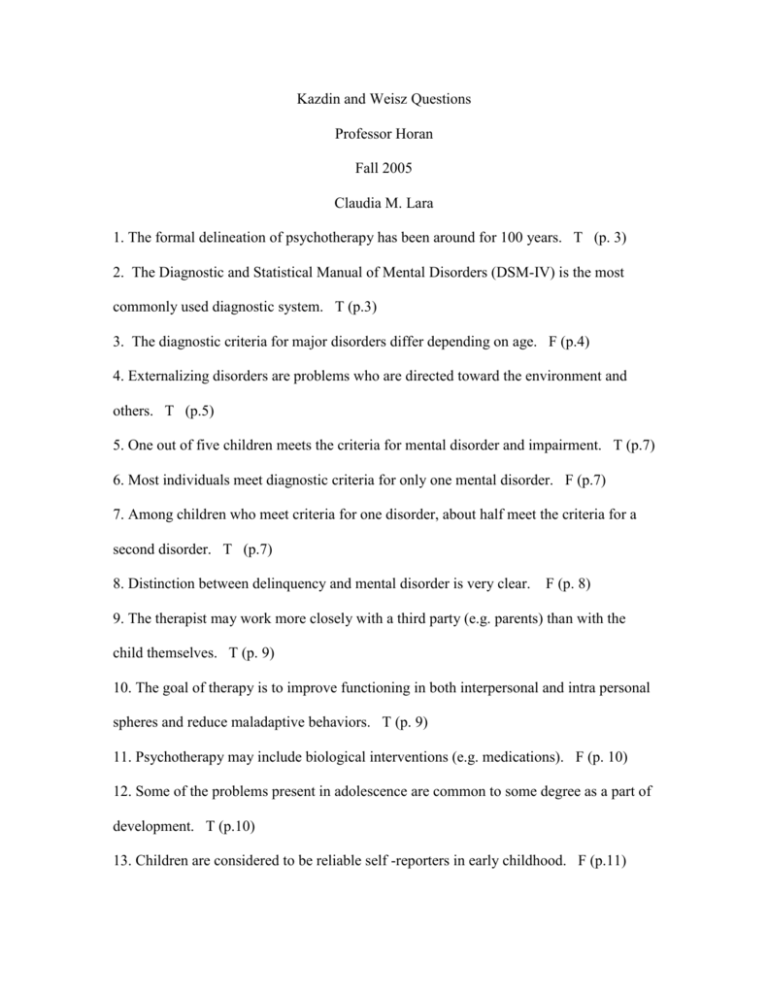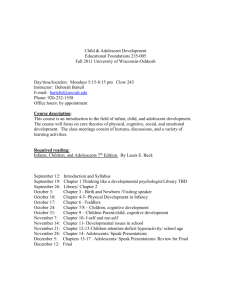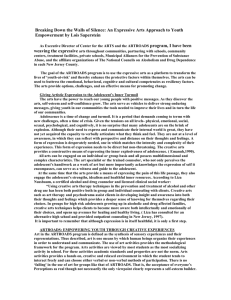kw_lara_claudia
advertisement

Kazdin and Weisz Questions Professor Horan Fall 2005 Claudia M. Lara 1. The formal delineation of psychotherapy has been around for 100 years. T (p. 3) 2. The Diagnostic and Statistical Manual of Mental Disorders (DSM-IV) is the most commonly used diagnostic system. T (p.3) 3. The diagnostic criteria for major disorders differ depending on age. F (p.4) 4. Externalizing disorders are problems who are directed toward the environment and others. T (p.5) 5. One out of five children meets the criteria for mental disorder and impairment. T (p.7) 6. Most individuals meet diagnostic criteria for only one mental disorder. F (p.7) 7. Among children who meet criteria for one disorder, about half meet the criteria for a second disorder. T (p.7) 8. Distinction between delinquency and mental disorder is very clear. F (p. 8) 9. The therapist may work more closely with a third party (e.g. parents) than with the child themselves. T (p. 9) 10. The goal of therapy is to improve functioning in both interpersonal and intra personal spheres and reduce maladaptive behaviors. T (p. 9) 11. Psychotherapy may include biological interventions (e.g. medications). F (p. 10) 12. Some of the problems present in adolescence are common to some degree as a part of development. T (p.10) 13. Children are considered to be reliable self -reporters in early childhood. F (p.11) 14. Culture and parental standards influence the perception of child adjustment. T (p. 12) 15. Psychotherapy should only be directed towards the child and not include the treatment of parents and teachers. F (p.13) 16. Getting a child to come to treatment is not an obstacle in psychotherapy. F (p. 14) 17. About half of child patients drop out of treatment prematurely and against the advice of the therapist. T (p. 15) 18. Behaviors that are developmentally normal at a younger age can become atypical at a later age. T (p.21) 19. Developmental issues do not to be addressed before designing a treatment strategy for adolescents. F (p.21) 20. A different version of the same treatment can be used to effectively treat a wider range of children and adolescents. T (p.22) 21. During adolescence, relations with the parents are most likely to be considered in treatment. F (p.22) 22. Authors of books or meta-analyses are more likely than authors of empirical paper to consider developmental issues within cognitive behavioral therapies. T (p.23) 23. Many effective psychotherapies for adolescents are adaptations of either treatments for adults or young children. T (p.23) 24. Cognitive behavioral techniques do not require complex symbolic processes; therefore it is unimportant that the patient have a high level of cognitive development. F (p.24) 25. As children progress through adolescence, the peer group takes a more significant role than the parents. T (p.24) 26. A mediator is a variable that specifies a mechanism by which a predictor has an impact on an outcome. T (p.27) 27. Vygotsky suggested that psychological processes have no social basis. F (p. 27) 28. It is possible that more advanced cognitive abilities in children and adolescents can exacerbate some types of psychopathology. T (p. 27) 29. Assessing development in children and adolescents is very straight forward and reliable. F (p.27) 30. Therapy might have to be given to a child or adolescent intermittently at different periods when the child experiences prior trauma. T (p.30) 31. Knowledge of developmental norms serves as a good basis on which to make good diagnostic judgments. T (p.30) 32. The frequency and nature of most psychological disorders does not vary as a function of age. F (p. 32) 33. Equifinality is the process by which a single disorder is produced via different pathways. T (p.33) 34. There is no potential in integrating developmental research into clinical practice. F (p.37) 35. Informed consent is the key defense against harm in a research design. T (p.60) 36. The use of psychotropic drug treatments in children and adolescents has been statistically proven safe. F (p.60) 37. The boundaries between ethical issues and legal issues in mental health are often unclear. T (p.61) 38. The Belmont Report is the historical starting point for ethical principles in human research. T (p.61) 39. Four major principles dictate ethical practice in research with human beings. F (p. 61) 40. The Code of Federal Regulations on the Protection of Human Subjects was the first research guidelines issued. T (p.62) 41. It is important to have a balance between risk and benefit for research project to be considered ethical. T (p. 63) 42. Informed consent is considered the foundation of ethical practice in research with children and adolescents. T (p.65) 43. Obtaining consent from children and adolescents can become complex, because it may also involved the parent and/or guardian. T (p. 65) 44. Every state considers an adolescent a legal adult at the age of 18. F (p.65) 45. In research with children the risks and benefits should be weighed out by the participant and not the investigator. T (p.67) 46. The use of placebos in research with children and adolescents is controversial. T (p.67) 47. In the last five years the trials of treatment for children and adolescents has doubled. F (p.68) 48. Confidentiality is an obligation of the researcher since information about the children and adolescents may affect them negatively. T (p. 71) 49. The number of adolescents suffering from depression has risen in both clinical and research settings. T (p.148) 50. Rates of depression are significantly higher for boys than for boys. F (p. 148) 51. Interpersonal Psychotherapy for depressed adolescents (IPT-A) is an adaptation of Interpersonal Psychotherapy for Adults. T (p.149) 52. The focus of Interpersonal Psychotherapy is to reduce depressive symptoms and to help in interpersonal interactions. T (p.149) 53. Interpersonal experiences may have an effect on depressive symptoms. T (p.149) 54. Research shows that there is a difference between adolescent and adult depressive symptoms. F (p.149) 55. The overall goals and problem areas in both adult and adolescent interpersonal psychotherapy are the same. F (p.150) 56. The involvement of a parent or guardian in IPT-A is critical in the outcome of the treatment. T (p.150) 57. Adolescents whose families are supportive of treatment are more willing to participate and finish the treatment. T (p.151) 58. IPT-A is suitable for adolescents who have histories of severe interpersonal problems. F (p.151) 59. The three phases of treatment in IPT-A are: initial phase, middle phase, and termination phase. T (p.151) 60. Grief is considered a problem in an adolescent when it becomes abnormal and/or is prolonged. T (p.155) 61. It is important to encourage the adolescent to explore his of her feelings relating to their problems is critical. T (p.157) 62. Interpersonal deficits in adolescents do not usually impede on developmental tasks. F (p.157) 63. Adolescents from single-parent families have a greater probability of suffering from depression. T (p.158) 64. The efficacy of IPT-A has been demonstrated in two controlled clinical trials. T (p.162) 65. IPT-A aim to reach a broader range of adolescents by providing treatment in community-based settings. T (p.162) 66. Child aggression has become a central focus of interventions because of its relationship with negative behaviors like delinquency. T (p.263) 67. Aggression usually begins in adolescence rather than early childhood. F (p.263) 68. There is no common definition for aggressive behavior. T (p.263) 69. Adolescent anti-social behaviors are though to be a result of a combination of familial and personal factors. T (p.256) 70. Academic progress has no effect on aggressive behavior. F (p.264) 71. Aggressive children have trouble interpreting information, and therefore respond in non traditional ways. T (p.264) 72. Aggressive children demonstrate deficiencies in the amount and quality of solutions generated in problem solving. T (p.265) 73. Children are confident that aggressive solutions will lead to negative consequences. F (p.265) 74. Children become less hostile as they are more physiologically aroused. F (p.265) 75. Parenting styles have an effect on adolescent antisocial behavior in both direct and indirect ways. T (p.265) 76. The Anger Coping Program believes group therapy is less beneficial for antisocial children. F (p.265) 77. Children with poor social skills seem to benefit the most from the Anger Coping Program. T (p.266) 78. Assessment instruments can help with individualizing treatment goals for a child’s specific difficulties. T (p.256) 80. The Anger Coping Program uses cognitive-behavioral techniques in treatment. T (p.267) 81. Rigid adherence to treatment goals in the Anger Coping Program is necessary. F (p.267) 82. Positive feedback is included in every therapy session in the Anger Coping Program. T (p.271) 83. The Coping Power Program is an extension of the Anger Coping program that includes a parent component. T (p.271) 84. The Anger Coping Program has been shown to only have a immediate effect on adolescents. F (p.276) 85. Adolescents treated for aggression do not only show improvement in behavior but also show improvement in academic work. T (p.277) 86. It is known that contextual factors have an effect on a child’s level of aggression. (p.277) F 87. Booster interventions can play an important role in maintaining positive effects on aggression. T (p.278) 88. Ongoing training is necessary for practitioners of the Anger Coping Program so they may cope with unexpected problems that arise in treatment. T (p. 279) 89. About one percent of all adolescent girls ages 15-19 suffer from anorexia nervosa. T (p.358) 90. A good indicator that anorexia nervosa is present in females is amenorrhea. T (p.359) 91. Most adolescents with eating disorders do not meet full criteria for anorexia nervosa or bulimia nervosa. T (p.359) 92. Most adolescents that fall in to the diagnosis of eating disorder not otherwise specified are not impaired emotionally. F (p.359) 93. Children and adolescent usually reach the later stages of starvation more rapidly than adults. T (p.359) 94. A practitioner should wait to intervene until a child or adolescent meet the full criteria for anorexia nervosa and bulimia nervosa. F (p.359) 95. Family therapy has been proven to be the most effective intervention for adolescents with eating disorders. T (p. 360) 96. Behavioral Family Systems Therapy (BFST) is made up of a team that includes a therapist, pediatrician and a dietician. T (p.360) 97. BFST focuses on the fact that families are responsible for the behaviors associated with anorexia nervosa. F (p.360) 98. The length of BFST varies depending on amount of weight to be gained and the severity of the eating disorder. T (p.361) 99. Families are best engaged in the treatment when the adolescent and parent are seen together for the first sessions. F (p.361) 100. Weighing the adolescent in every session is an important part of the treatment. T (p.360) 101. Typically, an adolescent beginning treatment expresses a great deal of anger and refuses to commit to making changes in their eating habits. T (p.363) 102. Most parents do not commit to therapy if the anorexic adolescent has objections. F (p.363) 103. Parents have total control over what the anorexic child eats through the whole treatment process. F (p.365) 104. Cognitive distortions about food intake and body shape are treated through cognitive restructuring. T (p.366) 105. Most anorexic patients must consume about 5,000 calories daily to gain one pound per week. T (p.366) 106. About 50% of the time cognitive restructuring exercises fail to change the adolescents’ cognitions. T (p.367) 107. When the adolescent has maintained the targeted weight for at least 3 months, the therapist plans for termination of treatment. T (p. 368) 108. Ethical constraints prevent including placebo control groups which are necessary to demonstrate the effectiveness of BFST. T (p.372) 109. BFST is currently the best evidence-based psychotherapy for the treatment of eating disorders. T (p.372) 110. Hispanic youth present the highest prevalence rates of depression and substance abuse. T (p.425) 111. Adherence to more traditional Hispanic cultural values is associated with higher risk of drug use among the Hispanic youth. F (p.425) 112. Culturally competent mental health professionals have a positive effect on the treatment of Hispanic youths. T (p.425) 113. The growth rate of the Hispanic population in the U.S. is seven times more than any other minority population. T (p.426) 114. The most common psychological symptoms among Hispanic youth include anxiety, depression, and conduct disorders. T (p.429) 115. Older Hispanic adolescents identify psychologically with cultural role models. F (p.432) 116. Culturally sensitive services enhance the effectiveness of any psychological treatment. T (p.433) 117. In 1998, The Journal of Clinical Child Psychology devoted an entire issue to reporting on empirically supported youth treatments. T (p.448) 118. Much research has been done on the ways therapist behavior relates to treatment persistence and outcome. F (p.449) 119. The course of research on child and adolescent treatments is noteworthy; it has grown especially in the last few decades. T (p.449) 120. A great deal of research needs to be done in the area of child and adolescent psychology. T (p. 449)








